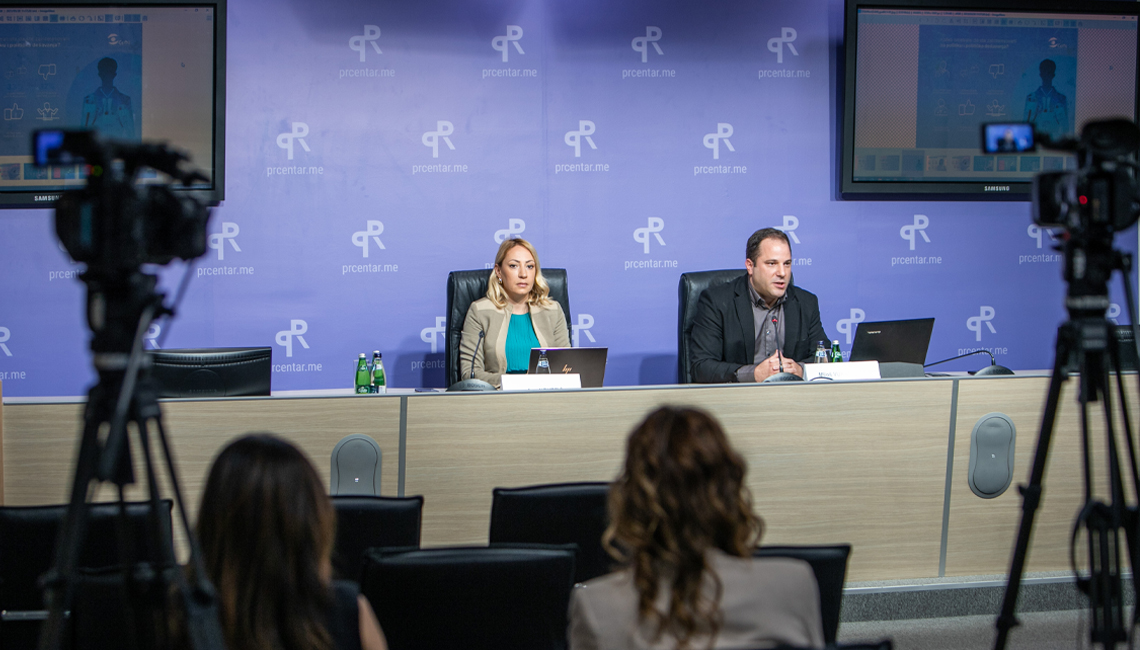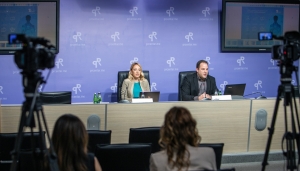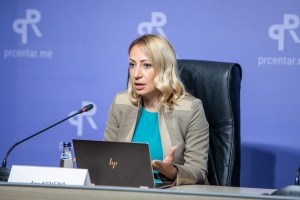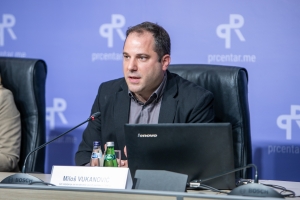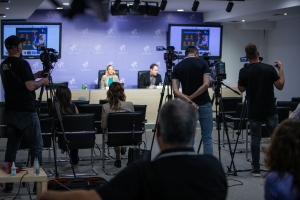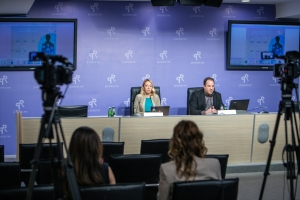In Montenegro, nearly 60 percent of citizens obtain information about political events and electoral offerings through traditional media, as revealed by a study conducted by the Center for Monitoring and Research (CeMI).
The research, titled "How do citizens of Montenegro inform themselves about political events and electoral offerings?" was conducted on a representative sample of 1,004 Montenegrin citizens.
Miloš Vukanović, the Head of the Department of Public Policy Research at CeMI, stated that in response to the question about their primary source of information.on politics and political events, 59.4 percent of citizens indicated television, newspapers, or radio.
"The research showed that 14.2 percent of them are informed through information portals, and 16.2 percent through social networks. Also, the research showed that, when it comes to the source of information, 57.8 percent of them have the greatest trust in news and information from traditional media, while 16.7 percent have it in news and information they get through social networks, 13.2 percent of them have confidence in both sources, and 12.3 percent don't trust either of them," stated Vukanović at the press conference.
He mentioned that citizens were asked about their level of interest in politics and political events, with 33 percent responding that they were partially interested, and an equal percentage indicating both interest and lack of interest in these matters.
"According to the research, 14 percent of citizens stated that they are interested in political events, 2 percent are very interested, and 1 percent cannot decide. If we cumulatively examine these data. we find that almost 80 percent of citizens are interested in political events to some extent," Vukanović said.
He emphasized that the question is how to get the most information about the political offer, 52.9 percent of citizens answered that they receive information through television, newspapers, or radio, 17 percent through information portals, 14.2 percent through Facebook, 9.8 percent through conversations with family and friends, 2.6 percent through Twitter and 2.2 percent via Instagram.
"When asked if they have profiles on social networks, 55.6 percent said they have a profile on Facebook, 42.1 percent on Instagram, 17.3 percent on TikTok, 9.4 percent on Telegram, and 8.9 percent on Twitter," said Vukanović.
Responding to the question of which social media platforms they use to inform themselves about political events, 23.8 percent stated that they inform themselves to some extent or completely through Facebook, 17 percent through Instagram, 9.3 percent through Twitter, 9.3 percent through TikTok, and 8.2 percent through Telegram.
"We asked citizens to rate how reliable the information on social media pages can be as a source of political information and the highest average reliability rating (on a scale of 1 to 5) of 3.04 was given to official statements by politicians and political parties. Accounts of religious communities followed them with a rating of 3.03 and accounts of non-governmental organizations with a rating of 2.93. At the bottom of the trust perception scale are fake accounts, accounts of ordinary citizens, and profiles of unregistered media," Vukanović said.
He said that they also asked citizens to what extent the profiles and content they share on social networks influence their attitude about political events, stating that the research showed that the content shared via Twitter has the greatest influence, with an average trust rating of 3.03 and Facebook with an average rating of 2.94.
"We also asked citizens how reliable a source of political information mim pages (anonymous profiles) are, 20.5 percent of them said that they aren’t a reliable source at all, 7.5 percent that they are somewhat reliable, 23.7 percent said that they are and they aren’t reliable, 16.6 percent somewhat reliable, and only 2.3 percent of them consider it a completely reliable source,” said Vukanović.
The research also revealed that 28 percent of citizens believe that profiles and content shared on social media have some influence on citizens’ opinions about political events.
Ana Nenezić, the Executive Director of CeMI, stated that the research showed that, to stay informed about political events, 25.9 percent of citizens frequently follow "Televizija Vijesti," 25.8 percent follow RTCG, 7.6 percent follow "Gradska TV," 7.4 percent follow "Pink M," 6.6 percent follow "Prva," 3.9 percent follow "TV E," 3.9 percent follow "Nova," 3.7 percent follow "Nikšić," and 3.2 percent follow "Adria."
"When we combine the responses from citizens who frequently or sometimes follow each television station, 72.7 percent of them stated that they frequently or sometimes follow 'Televizija Vijesti,' 65.2 percent follow RTCG, 39.2 percent follow 'Prva,' 38.3 percent follow 'Gradska TV,' 32.8 percent follow 'Pink M,' 31.7 percent follow 'Nova,' 31.2 percent follow 'TV E,' 29.3 percent follow 'Nikšić,' and 24.4 percent follow 'Adria,'" Nenezić noted.
She mentioned that citizens were also asked how much they follow various online portals to stay informed about political events. 16.2 percent stated they frequently obtain information from "Vijesti," 11 percent from CDM, 6 percent from "M portal," 5 percent from "Dan," 4.8 percent from "Pobjeda," 4.1 percent from "IN4S," and 3.1 percent from "Borba."
"When we combine the responses for frequently and sometimes following different online portals to stay informed about political events, 54.3 percent stated that they frequently or sometimes follow 'Vijesti,' 34.9 percent follow CDM, 28.4 percent follow 'Dan,' 28.1 percent follow 'Pobjeda,' 25.3 percent follow 'M portal,' 22.2 percent follow 'IN4S,' and 19.6 percent follow 'Borba,'" Nenezić said.
She mentioned that citizens were also asked how much they trust the media, and 34.3 percent stated they completely or somewhat trust 'Vijesti,' 28.1 percent trust 'RTCG', 23.8 percent trust 'CDM', 21.2 percent trust 'Prva,' 20.2 percent trust 'Gradska TV,' 18.3 percent trust 'Nova M,' 18.1 percent trust 'Televizija Nikšić,' 16.4 percent trust 'Antena M,' 15.6 percent trust 'Pobjeda,' 14.4 percent trust 'TV E' and 'Borba,' 14.2 percent trust 'TV Adria' and 'IN4S.'
"We were also interested in how much citizens follow the regional media. They were asked to name the three media they follow most often. Most citizens mentioned Aljazeera Balkans, 39.6 percent, followed by RTS with 32.1 percent, Happy 21.5 percent, Radio Slobodna Evropa 16.3 percent, and pink.rs 10.6 percent," said Nenezić.
Nenezić explained that they asked citizens about the influence of various factors on the media, and citizens were able to rate each factor's impact on individual media outlets on a scale of 1 to 5. She clarified that if the average rating is above 2.5, it can mean that, on average, citizens believe that the mentioned factors, whether external or internal, have a certain influence on the selected media.
The research showed that citizens believe that, among the options provided, large companies have the most significant influence on the media, and this view applies to almost all the media outlets surveyed.
"We also asked citizens about the influence of large companies on reporting, and the research revealed that they have the most influence on 'Gradska TV,' 'Prva,' RTCG, and 'Antena M.' Following them are 'Vijesti,' 'IN4S,' ' CDM', 'Nova M,' 'Borba,' 'TV E,' and 'M portal,'" Nenezić said.
When asked how influential Montenegrin non-governmental organizations influence reporting, Nenezić said that Gradska and RTCG received a rating of 2.6, Vijesti 2.5, Nova M, Prva and CDM 2.4, TV E and M portal 2.3 and 2.2 Borba and IN4S.
"When asked how much the EU influences media reporting, the research showed that RTCG and Gradska have the greatest influence, followed by Vijesti, CDM, Nova M, and Antena M," said Nenezić.
She also mentioned that citizens were asked to what extent the ruling majority influences media reporting, and the research showed that it has the most influence on 'Prva,' 'IN4S,' and 'Borba,' followed by RTCG and 'Vijesti,' 'Nova M' and 'Antena M,' and after them 'Gradska TV,' 'TV E,' 'M portal,' and CDM.
"We also asked citizens to what extent the opposition influences reporting, and the research revealed that it has the most influence on 'Gradska TV,' followed by RTCG, CDM, 'Antena M,' 'Nova M,' 'TV E,' and 'M portal,' 'Prva,' 'Vijesti,' 'Borba,' and 'IN4S,'" Nenezić said.
She stated that in response to the question of how much the Government of Montenegro influences media reporting, the research showed that it has the most influence on 'Prva,' followed by 'IN4S,' 'Vijesti,' RTCG, 'Borba,' 'Nova M,' 'Antena M,' 'Gradski,' 'TV E,' 'M portal,' and CDM.
She emphasized that the data from the research clearly show the depth of polarization in society, which is also reflected in the media.
"Citizens perceive that influences exist, and they recognize them much more about domestic political actors than foreign countries and influences. They believe that there are fake news, and it affects how their political beliefs and thoughts are formed. The research also showed that they predominantly use traditional media as a source of electoral offerings and political information," Nenezić said.
